|
Page 2 of 9 - Prior - Next
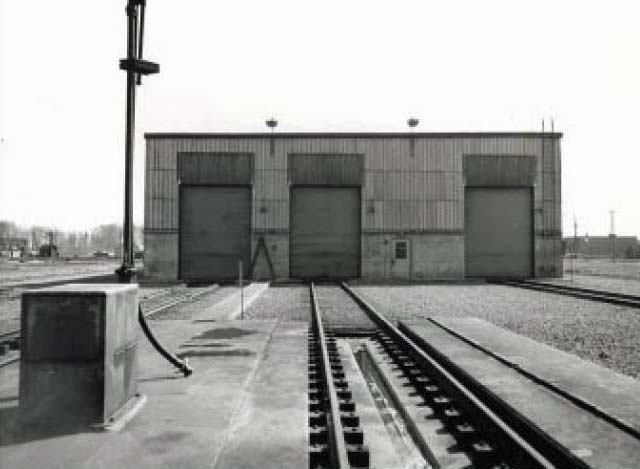
Inbound view of the new St. Luc Diesel Shop - 1955 Photographer unknown.
In the 1950's the new president-to-be, Norris R. "Buck" Crump, ushered in a new era
of diesel power for the Canadian Pacific Railway. And so the St. Luc Diesel Shop began...
| |
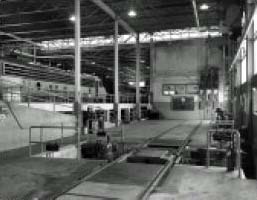
This included a new state-of-the-art roll-on wheel truing machine - 1955 Photographer
unknown.
|
In 1953, the first of three major construction phases began to build the St. Luc Diesel Shop.
In 1955 the first three run through tracks were finished ready to service the growing fleet of diesel locomotives (now numbered Tracks 10, 11, and
12). These facilities incorporated advanced designs and new technology that included run through Service Bays where locomotives requiring
servicing entered from the east end of the Shop and fully serviced locomotives exited to the west.
The Shop's design also featured lowered floors, depressed pits below the shop floor (to allow better access to the underside of each locomotive),
and elevated platforms to easily access the carbody and engine areas.
These elevated platforms were joined at the front of the shop by small (7 foot x 11 foot) air operated piston driven drop tables that could be
raised and locked into place. This was to permit the platform-to-platform flow of shop personnel and equipment to cross and work from the
platforms, or to be lowered to track level to allow a serviced locomotive to exit the shop. This thru-put process was much speedier than the
traditional roundhouse design.
| |
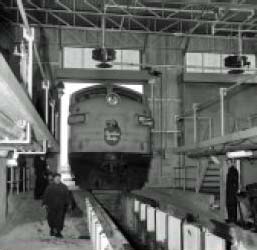
This included a new state-of-the-art roll-on wheel truing machine - 1955 Photographer
unknown.
|
The heating system, critical in our cold winters, used large blowers to force the steam
heated air through heating ducts built into the floor of the Diesel Shop. This not only kept the shop warm but also cold damp cement floors were a
thing of the past.
Ever financially and ecology minded, St. Luc Diesel Shop was a pioneer in the recovery of gray waste water and used engine oil. The spent liquids
were pumped to separate treatment areas where the gray water was treated before being put into the sewage system, a safe practice still in place
today. The oil was cleaned, put into storage tanks and was originally burned in the large boilers at the Power House. Now, the oil is sold to a
specialized recycling company.
Since its beginnings, the St. Luc Diesel Shop has played an important role in the development of the railway's diesel program.
In 1956, two more identical run-through service bays were added as part of the second phase of construction. (now numbered Tracks 8 and
9).
| |
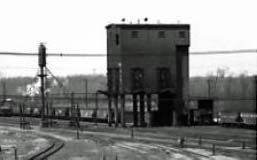
The Coal Chute as seen from the back of the Diesel Shop - 1963 Photographer unknown.
|
Today, most shop personnel find it hard to believe that their diesel shop was actually
constructed in three phases. The last phase of construction was the addition of a drop-table to change out of the new electric traction motors.
Also, a place was needed to change the wheel sets of these motors.
So in 1957, the High Bay Heavy Service Area was built which included a 100 ton Whiting drop table and a 40/10 ton double-hook Hepburn overhead
crane. This crane has one trolley with independently operated hooks. This feature allows whole locomotive trucks to be turned over to facilitate
rebuilding the motor/truck unit (these tracks are now numbered Tracks 13 to 17).
St. Luc Diesel Shop employees have witnessed many changes in the past half century and proudly acknowledge it as the major running repair shop in
the eastern region of the Canadian Pacific Railway.
In 1962 a garage was built for the Hi-Rail Mobile Crane and the road/rail business car, M260. In 1981 a rolling sand gantry was installed at the
"Coal Chute".
In 1986, the steam-era coal chute was demolished. However, traditions die hard and the inbound track area, where the facility was once located, is
still referred to as "The Coal Chute".
| |
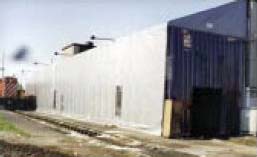
The Locomotive Washing System Enclosure - 1992 Photographer unknown.
|
In 1991, a covered locomotive washing system was installed beside the Shop on Track 7. This
outdoor system which operates during the warmer months only has been affectionately dubbed "The Car Wash".
Also in 1991, the water tower beside the shop on track 18 was demolished. A little known fact is that the water tower, which was designed to
supply water to the shop in the event that the City of St. Luc was unable to, was never used.
In 1992, a 20/8.5 ton double hook DEMAG (#81099) crane, transferred from Angus Shops when that facility was closed, was installed in the high bay
service area. That same year, a part of the steam shop was converted into an engine head rebuild area for the aging ALCO fleet (American
Locomotive Company). St. Luc employees can be proud of its record for servicing the much maligned ALCOs.
| |
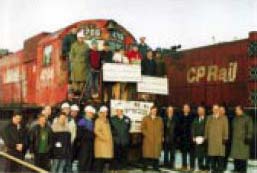
The Final Farewell - 23 Dec 1993 Photographer unknown.
|
On 23 Dec 1993, emotions were mixed when in a farewell ceremony, CPR president, Rob Ritchie,
shut down CP 4706, the last active 6-axle ALCO locomotive.
In August 2000, in an effort to become more efficient, Canadian Pacific contracted out the maintenance of the four-axle locomotive fleet to the
OmniTrax Company. Efficiencies were expected to come from an innovative servicing program whereby the locomotive maintenance personnel traveled to
the locomotives and serviced them on-site, rather than have the locomotives travel to the shop. After three years the CPR recognized its' own
well-trained employees could perform the same tasks and be yet more efficient and cost effective.
So in 2003, Mobile Locomotive Maintenance (MLM), was launched in Toronto. Then in 2005, the program was rolled out to each of the local service
areas and Michel Daoust and his mobile men began to call St. Luc home.
| |
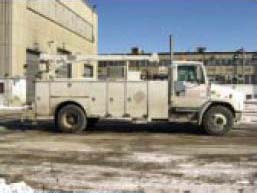
The Mobile Repair Vehicle (MRV) - Date/Photographer unknown.
|
The Mobile Locomotive Maintenance now has two trucks: a mobile service vehicle (MSV)
and a mobile repair vehicle (MRV). Two crews of two diesel shop employees keep these trucks on the road 16 hours a day doing all Servicing (with
the exception of annual inspections) and repairs. Large tanks in the MSV truck keep oil and water to top up the Locomotives. A lifting boom,
welding machine, and air compressor on the MRV truck aid in trackside repairs. These tough all-weather crews are responsible for a large territory
which includes Hochelaga, Lachine, Delson, Vaudreuil, Rigaud, Ste. Therese, and more recently, St. Antoine.
In 2001, The roundhouse was partially demolished. Only 9 stalls remain, numbers 29 to 37. To some, this demolition seemed to signal the end for
the St. Luc Diesel Shop, however, nothing could be further from the truth!
After a couple of years of renting out space to Progress Rail, General Electric Locomotive Service Division came calling.
In 2003, the GE service contract allowed eighty-three GE AC4400 locomotives to call St. Luc their home. This move breathed new life into what was
beginning to appear as a deserted diesel shop. Also in 2003, the now "old" wheel truing machine was given a face lift. New electronics
and displays were installed allowing the operator a more precise "cut" of the wheel.
| |
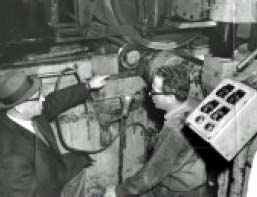
Pat Michaud receiving instructions - 1956 Photographer unknown.
|
St. Luc Diesel Shop was the third diesel shop built by the CPR, after shops built in Nelson, British Columbia, and Calgary, Alberta. Although the
St. Luc Diesel Shop was built in three stages, it is considered to be one shop encompassing 20,000 square feet. The Chief Engineer on the St. Luc
project was R.A. Emerson who followed plans made by the Chief Architect Laurence Laffoley. All materials used in the construction were top-grade
and were designed for the anticipated heavy work loads. The rails were brand new 130 lb. steel and the supports were made to accommodate future
heavier locomotives. The incoming tracks and outbound tracks were laid out so the hostlers, using hand lanterns at that time, could easily move
the locomotives into the different servicing areas. The run through locomotives go to the south side of the shop to be inspected, serviced, washed
and marshaled into new consists.
When first built, the St. Luc Diesel Shop was able to service 100 locomotives and make consists for 52 trains in any given 24 hour period.
Nowadays, with the larger horsepower locomotives capable of hauling longer trains, employees through-put 55 locomotives to make approximately 30
trains. Also, the stronger AC locomotives are more easily maintained and therefore less staff is required.
The torch is being passed on to the next generation of railway workers as many employees are retiring and many new faces and even new apprentices
are seen in the shop. We hope they will take pride in this shop and appreciate the history of toil and changes that have preceded them. To the
"old-timers", this shop has grown and given many a good living. Even though there was a threat of closure, the shop is now rising again
to give the next generation a future to build on.
Today, 50,000 gallons of diesel fuel and 200 gallons of lube oil are used per day to top up the locomotives that pass through the shop. Many
items, such as drinking water, first aid kits, flare kits, 2 fire extinguishers, that each locomotive must carry, are also verified and replaced
as necessary.
Every 90 days, locomotive inspections include changing the fuel, oil, and air filters. The brake shoes are checked every shopping, whether it is a
"Pit Stop", a regular 90 day, or a 180 day Inspection. During the annual inspection, the entire locomotive is closely examined on all
its components for wear.
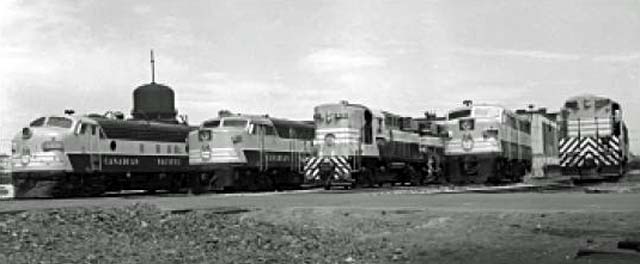
An array of diesel power in front of the St. Luc Shop - 1963 Photographer
unknown.
Over the years there have been a vast assortment of diesel locomotives from the earliest locomotives built in 1943 to the present day. This has
included ALCO switchers, 4 and 6 axle MLW's, GM's, and now GE locomotives. There have been a few special locomotives in the mix such as 8921,
4711, and 4744. The shop personnel have adapted and learned how to service the many different types of leased locomotives which have been
maintained at the diesel shop. Some of these different types include: Boston & Maine RS-3's, Delaware & Hudson S-2's, Bessemer &
Lake Erie F7's, Bangor & Aroostock GP7's, Baltimore & Ohio GP40's and Quebec North Shore & Labrador SD40's.
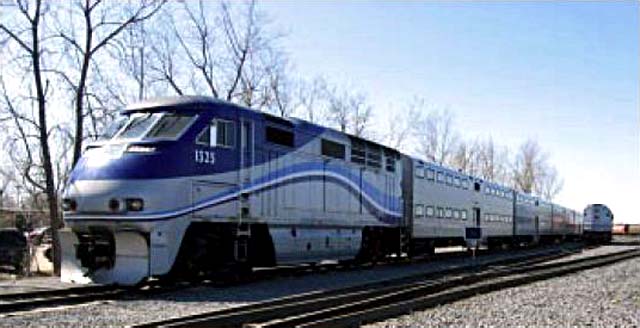
AMT 1325 and its train of double deck cars are serviced on Track 2 - 2007 Photographer
unknown.
At present, the St. Luc Diesel Shop maintains 209 locomotives for Canadian Pacific Railway. Also maintained are 16 locomotives and 104 cars that
are used in Montreal's Agence Metropoitaine de Transport (AMT) commuter service.
Page 2 of 9 - Prior - Next
|

|
Vancouver Island
British Columbia
Canada
|
|